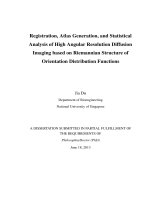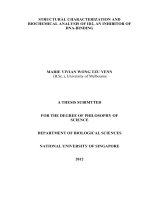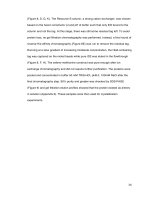Mathematical and computational analysis of intracelluar dynamics 8
Bạn đang xem bản rút gọn của tài liệu. Xem và tải ngay bản đầy đủ của tài liệu tại đây (32.53 KB, 4 trang )
157
Chapter 8
Summary and Conclusions
In this thesis, the dynamics of two important intracellular processes are investigated.
In Part I, the p53-AKT genetic network is modeled in terms of differential equations
to simulate the dynamics of the regulation of cell survival and death in the presence of
DNA damage and growth factor. In Part II, a new model to approximate pre-mRNA
folding during the process of transcription is proposed to study the dynamics of
dystrophin pre-mRNA secondary structures during transcription.
Despite the numerous coupled interactions among key cancer-relevant genes
in the p53-AKT genetic network and the extensive regulatory points at which p53 and
AKT impinge on apoptosis, it is somewhat surprising that no prior p53-AKT model
has been analyzed. Simulation of the p53-AKT genetic network predicts a bistable
switch that regulates pro-survival and pro-death states, i.e., there is a range of values
of control parameters where two stable steady states coexist. This prediction is not
only novel but also a strong one given that the bistability phenomenon is generally
conserved under wide variations of kinetic parameters and under network models with
various levels of mechanistic details. In contrast to a monostable switch, a bistable
switch prevents arbitrary switching between the two cellular states in the presence of
cellular noise. Furthermore, finite perturbations within the bistable region can switch
the system from one cellular state to the other, thereby providing an additional
mechanism to regulate the switch. Taken together, analysis of the switching
158
dynamics between the two steady states of the system leads to the understanding of
how cells regulate the switch between cell survival and death. Interestingly,
bistability between apoptotic and non-apoptotic protein activities has also been
predicted from models analyzing specific sub-networks of the apoptosis pathway. For
instance, bistability is predicted in mutual activation loops between CASPASE-3 and
CASPASE-9 and between CASPASE-3 and CASPASE-8 (Legewie et al., 2006;
Eissing et al., 2004, 2005). Bagci et al. (2006), on the other hand, predicted
bistability arising from the kinetic cooperativity in the formation of the
APOPTOSOME complex, which composed of APAF-1, PRO-CASPASE-9 and
CYTOCHROME C.
The p53-AKT network is also predicted to exhibit oscillatory dynamics under
certain conditions. The role of these oscillations of intracellular p53 protein levels
upon DNA damage in cell survival and death in the context of the p53-AKT network
is investigated. Two key effects of p53 oscillations are elucidated – lowering of pro-
apoptotic threshold level of irradiation intensity at which switching to pro-apoptotic
cellular state occurs and ability to express more amounts of p53-target genes products.
As a result, oscillatory p53 could commit cells to apoptosis faster and at lower
threshold level of irradiation intensity. Therefore, p53 oscillations are predicted to
sensitize cells towards apoptosis upon IR. This prediction can also be interpreted as a
decrease in tolerance to IR-induced DNA damage in cells that induce p53 oscillations.
As the consequences of p53 oscillations have so far remain elusive, the results
obtained in this study are significant. Most importantly, the results show for the first
time that p53 oscillations do have biological functions. It is worth noting that this
prediction has the potential to advance the field as the scientific community has not
159
yet explore the consequences of p53 oscillations beyond the p53-MDM2 feedback
loop. Given that oscillatory p53 has increased ability to express more amounts of
target genes products that includes DNA damage repair and cell cycle arrest genes,
this insight is especially noteworthy, as roles of such oscillations in these important
biological processes might exist as well. The novel insights gained from this work are
facilitated by analyzing the p53-MDM2 feedback loop in tandem with the p53-AKT
genetic network. Such insights cannot be deduced from the current models that
analyze the p53-MDM2 loop in isolation, which focus on reproducing experimentally
observed p53-MDM2 oscillations and explaining the underlying mechanisms
(Ciliberto et al., 2005; Ma et al., 2005; Wagner et al., 2005; Geva-Zatorsky et al.,
2006; Zhang et al., 2006).
In Part II, a computational model to approximate pre-mRNA folding during
the process of transcription (co-transcriptional) is used to predict the secondary
structures of dystrophin pre-mRNA at each step of transcriptional analysis. Using the
predicted results, novel scoring methodologies are developed to quantify and analyze
the dynamic changes in the co-transcriptional binding accessibilities of AON
(antisense-oligonucleotides) target sites in the pre-mRNA. Remarkably, dynamics of
co-transcriptional binding accessibilities of AON target sites could statistically
correlate with efficacy and efficiency of 94% of previously reported AONs in their
ability to induce selective removal of exons in the dystrophin pre-mRNA. The most
efficient AONs consistently bind to target sites on the dystrophin pre-mRNA that are
accessible for binding during the entire transcription process. This result is in stark
contrast to laboratories working in the same field where they reported no correlation
with AON efficiency with target site secondary structures that were obtained without
160
consideration of co-transcriptional effects. In addition, four key novel insights
pertaining to AON efficacy and efficiency deduced in this study are used to determine
novel AON target sites that could induce the removal of a particular exon in wet
experiments; previous efforts by the scientific community have failed to remove this
exon successfully. As AON target sites must be customized to treat Duchenne
muscular dystrophy patients, the results from this study could be applied to determine
target sites systematically in place of current trial-and-error means, which could
reduce the cost and waiting time of therapy.
In conclusion, the use of models has greatly aided in the understanding of the
two intracellular processes studied. In particular, modeling is especially useful in the
analysis of the p53-AKT network because of the nonlinear dynamics arising from
various interactions and inherent feedback loops. Notably, besides being able to
reproduce existing experimental trends, predictions and insights generated from these
models are novel and if validated in experiments, they could potentially advance the
knowledge of the field. Modeling is also valuable in the analysis of the dynamical co-
transcriptional binding accessibilities of an AON target site, as co-transcriptional
secondary structures of an elongating pre-mRNA cannot be directly observed by
current experimental methods. Therefore, given the expanding knowledge base of
interactions data among cellular components, the use of modeling tools to understand
and explain cellular processes will be indispensable.









